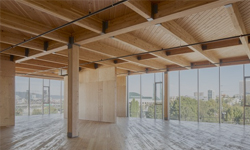


SHARE 

 |
 |
 Rethinking code requirements for "tall wood" buildings. Rethinking code requirements for "tall wood" buildings.posted: May 6, 2016 | from: AIA Architect One of the biggest obstacles to tall wood construction in the United States is that many cities have fire codes that don't permit wood-framed structures higher than four to six stories. Ironically, some of the same cities that once had eight-story heavy wood structures in the early 1900s now strictly forbid them. But firefighting practices have gotten much more sophisticated since that era. So have the materials used in fire-resistant walls and floors. Many architects and builders are now augmenting traditional gypsum with engineered materials that deliver the same fire resistance properties while lowering installation costs and reducing construction time. Read more |
 Construction workers leave the industry, skills mismatch emerging. Construction workers leave the industry, skills mismatch emerging.posted: May 10, 2016 | from: Reuters U.S. job openings increased in March to the highest level in eight months and layoffs continued to decline, indicating the labor market remains fairly robust. At least 50,000 construction workers voluntarily quit their jobs in March. The share of small businesses reporting job openings they could not fill jumped in April, revisiting cycle highs. There was also an increase in the proportion of small business owners saying that the quality of labor was their biggest concern. Read more |
| Global experts convene at National Earthquake Conference. posted: May 4, 2016 | from: PRNewswire As Taiwan, Japan, and Ecuador work to recover from recent deadly earthquakes, more than 160 different organizations and experts gathered at the 2016 National Earthquake Conference to share the latest advances in earthquake resiliency. The NEC critically examined the latest research and information from experts in building science and building product innovation, emergency management geology, seismology, resiliency programs and policies, social science, public outreach initiatives, scientific insights, and new technologies to drive better understanding of earthquake risk in the U.S. and create disaster-resilient communities. Read more |
| Housing markets continue to edge forward. posted: May 5, 2016 | from: National Association of Home Builders Markets in 119 of the approximately 340 metro areas nationwide returned to or exceeded their last normal levels of economic and housing activity in the first quarter of 2016. This represents a year-over-year net gain of 45 markets. The index's nationwide score ticked up to 0.95, meaning that based on current permit, price and employment data, the nationwide average is running at 95 percent of normal economic and housing activity. Meanwhile, 86 percent of markets have shown an improvement year-over-year. Read more |
| San Francisco passes mandatory solar ordinance for new buildings. posted: April 20, 2016 | from: CS Monitor San Francisco is the first major city in the United States to require solar panels on all new buildings under 10 stories. The city's Board of Supervisors unanimously passed the ordinance this week. The new law takes effect January 2017. The legislation says the requirement is needed given San Francisco's coastal location and rising sea levels. The requirement also helps the city reach its goal of eventually using 100 percent renewable energy. San Francisco's ordinance also builds on a state law that requires a portion of the roofs of new small- and mid-sized buildings to be solar-ready. Read more |
| Report: Efficiency could provide big benefits to low-income renters. posted: April 25, 2016 | from: Midwest Energy News Low-income households would benefit significantly from efficiency upgrades, according to a new report from the American Council for an Energy Efficient Economy and the coalition Energy Efficiency for All. The report examined data from 48 U.S. cities and found low-income households spend up to three times as much of their income on energy costs as higher-income households. They often pay more for energy because they are more likely to live in inefficient, multifamily buildings where they do not have control over heating and cooling or the power to make efficiency upgrades. Read more |
| NYC residential building permits surged 180 percent in 2015. posted: May 10, 2016 | from: NYC Construction Outlook Update The New York City Department of Buildings authorized construction of 56,528 residential units in 1,998 buildings in 2015, an almost 180 percent increase from the 20,329 units in 1,513 buildings that were permitted in 2014. Part of the reason for the jump? Developers who applied for permits at the end of 2014 in advance of pending changes in the building code. Also, the pending expiration of the 421 — a program that created an urgency to get permits approved in late spring. Read more |